Every day, the Texas Department of Transportation reports an average of ten deaths on the roads of Texas. Unfortunately, San Antonio ranks poorly for traffic safety, with the San Antonio Current revealing that it’s the third most dangerous city for drivers in the Lone Star State.
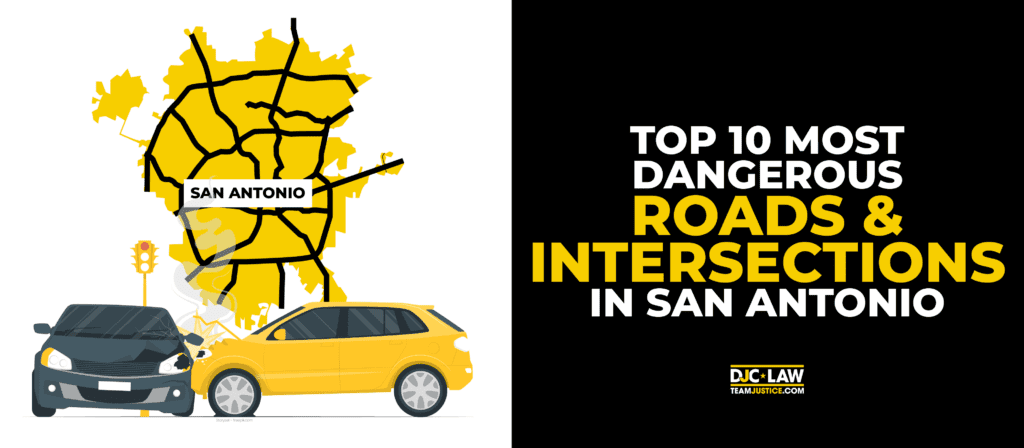
Naturally, the overall figures don’t account for differences in where you drive. A small smattering of roads account for the majority of injuries and fatalities in the Alamo City. For example, WOAI reports that just 1% of the city’s roads account for 40% of all pedestrian injuries and deaths.
Keeping yourself safe means knowing where these hotspots lie so that you can stay extra alert for potential dangers coming your way. Today’s guide discusses the city’s top ten most dangerous roads and intersections.
Key Takeaways
-
San Antonio’s most dangerous roads have been ranked using several criteria, including accident frequency, injury rate, and the number of fatal crashes, using state and federal crash report data.
-
The most dangerous road in San Antonio is Culebra Road, followed by Loop 1604, known as “The Death Loop.”
-
San Antonio’s highways are among the most dangerous in Texas due to high traffic volumes, speeding, failure to yield, and heavy commercial traffic from the Interstate 35 Corridor.
-
Drivers can protect themselves against the most dangerous roads by driving defensively, avoiding the busiest driving times, and improving their driving habits.
-
If you’re involved in a San Antonio car accident that wasn’t your fault, contact a lawyer to take control of your case and maximize your settlement.
San Antonio Most Dangerous Roads – How We Sourced the Data & Danger Rating Criteria
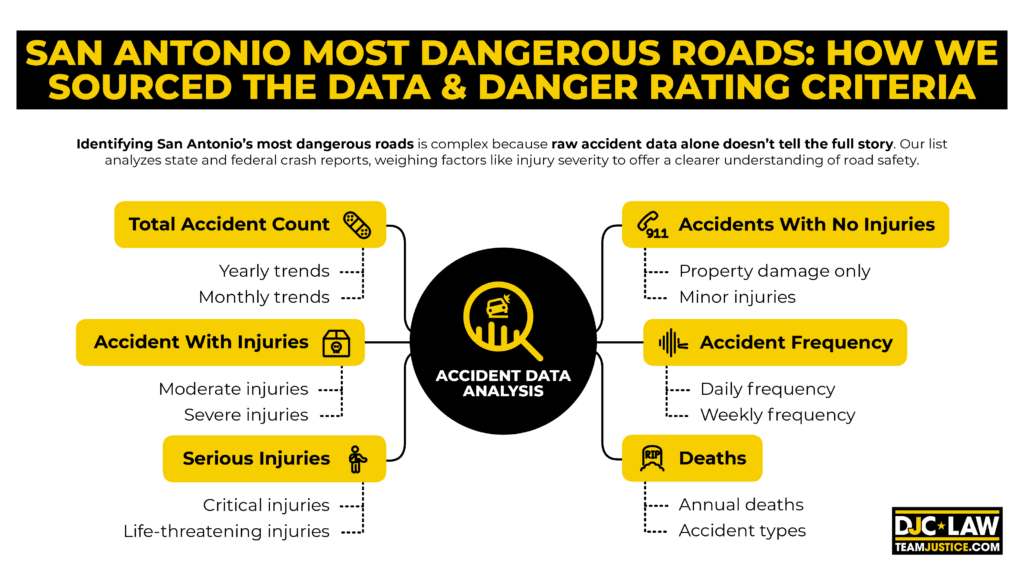
Determining the most dangerous roads in San Antonio is complex because it’s not as simple as looking at the accident data alone. Every crash report paints a picture, and not every accident is significant, especially when no injuries have been reported.
Compiling this list means we’ve sourced data from both state and federal crash report data, but we’ve further split it to account for issues like:
-
Total accident count
-
Accidents with no injuries
-
Accidents with injuries
-
Accident frequency
-
Serious injuries
-
Deaths
By weighting accidents accordingly, we can cut through the noise and avoid naming a particular road just because it has a high rate of accidents. For example, if there are 500 accidents annually on a road with no injuries but 100 fatal accidents on another road, which street should you fear the most?
If you’ve suffered an injury or loss on one of San Antonio’s dangerous roads, consulting a San Antonio car accident lawyer can help you seek justice and compensation for your case.
Our careful weighting system enables us to factor in the actual dangers presented by each road and intersection in San Antonio, providing a more realistic view of the danger rating.
Top 10 Most Dangerous San Antonio Roads and Intersections
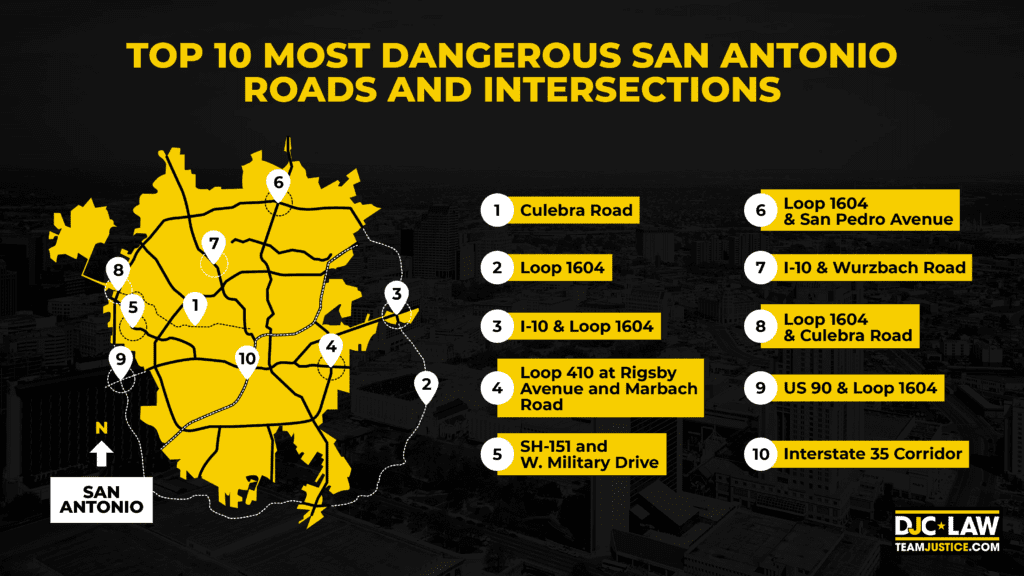
With that in mind, we’ve also found some interesting statistics about the nature of accidents. In particular, more than 37% of traffic fatalities in Texas involved a driver being impaired by drugs or alcohol, per the State of Texas Open Data Portal.
We found that speeding was a major cause of accidents in San Antonio. The San Antonio Report found that nearly 11,000 accidents in 2022 involved a driver speeding.
So, let’s take a trip down some of the most hazardous parts of San Antonio to find out which roads present the biggest risks in 2024.
1. Culebra Road
Culebra Road is the deadliest road in the whole city, with more than 40 lives claimed in the last decade. It’s a seven-lane speedway that consistently rates as the most dangerous place to drive in Mission City.
According to News4SA, Culebra Road is already reporting an average of one crash daily in 2024. Granted, not every accident leads to serious injuries, but it’s evidence that the road is causing severe problems.
The same article reported on a survey taken in the city in 2023. More than 50% of people said Culebra Road is fundamentally unsafe to drive on. However, the city is attempting to address this by introducing the 2022-2027 Bond Project for Culebra Road. Several improvements, including roadway reconstruction, traffic signals, and driveway approach enhancements, are expected to come into force.
2. Loop 1604
Loop 1604 is the second deadliest road in San Antonio and has also been named one of the most dangerous roads in the whole state. Known as “The Death Loop, an analysis by the San Antonio Express-News found that 196 car accidents had occurred on the road, resulting in at least one death in the last decade.
Initially, the road was a rural road designed for people in the city to reach the dairy farms just outside of the city. It gained its nickname in the 1980s because it became a poorly lit two-lane highway. Today, it’s a multilane highway that encircles San Antonio for around 95 miles.
At first glance, there’s nothing that makes this road particularly dangerous. However, residents frequently cite the volume of traffic. In short, the way traffic volumes are managed is poor, and the highway is likely not equipped to handle the growing volume of motorists using the road.
3. I-10 & Loop 1604
Loop 1604 is one of the most dangerous roadways in San Antonio, but it also boasts the deadliest intersection in the city. The I-10 & Loop 1604 intersection reported 90 car accidents in 2023, making this critical traffic juncture one of the worst places to drive.
The importance of the intersection can’t be understated. It’s one of the key access routes into the northwestern districts of the city, and it’s responsible for linking two critical highways. Naturally, high traffic volumes and its notoriously complex design increase the risk associated with this intersection.
Accidents often occur because of traffic attempting to merge and poorly handled lane changes. Plus, enormous speed variations between the highways and exit ramps make an elevated accident rate almost inevitable.
4. Loop 410 at Rigsby Avenue and Marbach Road
Loop 410 at Rigsby Avenue and Marbach Road suffers from many of the same problems as I-10 and Loop 1604. Its complex design and location close to commercial and retail areas bring higher traffic volumes and greater chances of accidents.
Locals already know how intimidating this intersection can be, with its multiple levels and lanes. There’s also a problem with substantial speed differences between traffic on the loop, leading to drivers misjudging distances and finding themselves in an accident.
Unfortunately, little can be done about this intersection without fundamental changes to the roadway design of the area.
5. SH-151 and W. Military Drive
SH-151 and W. Military Drive reported 77 car accidents in 2023, making it one of the more dangerous intersections you’re likely to encounter. It’s located in West San Antonio, just outside the city center.
The popularity of this intersection is due to its role as a connector between commercial and residential areas. Moreover, it doesn’t help that it’s located on the way to some of the city’s most popular attractions, including SeaWorld.
Again, high traffic levels are among the most significant contributors to accidents here. SH-151 itself is a westward route connecting the downtown area, whereas West Military Drive is an arterial road for local traffic.
Anyone who has driven this road knows that there are big problems regarding speeding as drivers try to beat the lights. Plus, drivers have been seen ignoring stoplights, resulting in side-impact collections. It’s clear this is an intersection where tensions commonly run high.
6. Loop 1604 & San Pedro Avenue
The Loop 1604 and San Pedro Avenue intersection is another connection to San Antonio’s most vital ring roads. Also known as US 281, San Pedro Avenue forms one of the major north-south routes across the city. It cuts through the heart of the downtown area and also serves as a significant airport thoroughfare.
Due to its importance to the city’s layout, high traffic volumes are a regular feature at this tricky intersection. It also doesn’t help that the North Star Mall is close to this junction, leading to merging difficulties and speed variance that naturally leads to accidents.
7. I-10 & Wurzbach Road
Approximately 65 car accidents were reported at this intersection in 2023. It’s no surprise because it’s an intersection that connects several residential areas with the South Texas Medical Center. Plus, I-10 happens to be an interstate highway, giving drivers access to Easy and West Texas.
Anyone encountering this junction knows how intense the traffic flow can get. Additionally, the combination of high-speed traffic moving along the interstate and the local thoroughfare of Wurzbach Road elevates the complexity of navigating this part of San Antonio’s road system.
Unfortunately, the problems here are compounded by drivers running red lights and ignoring stop signs.
8. Loop 1604 & Culebra Road
The two deadliest roads in San Antonio may lead to different destinations, but they also share an intersection. Approximately 72 car accidents, some fatal, were reported at this intersection in 2023.
It’s part of the growing northwest area of the city, with SeaWorld, residential communities, and different shopping and dining zones bringing everyone from locals to tourists into one chaotic intersection.
Two of the most common issues reported by drivers in this area include ignoring traffic signals and carrying out improper lane changes.
9. US 90 & Loop 1604
San Antonio boasts an incredible array of shopping zones, but the sheer scale of the city’s commercial sectors brings danger. The US 90 & Loop 1604 intersection saw 67 motor vehicle accidents in 2023.
It’s an intersection that sees a blend of high-speed vehicles coming from the highway and slower local traffic. As a critical juncture for both residential areas and shopping zones, drivers report aggressive driving behaviors in abundance at this intersection.
Some of the most common observations include tailgating, which increases the risk of rear-end collisions and failures to yield to turning and merging traffic.
10. Interstate 35 Corridor
The Interstate 35 Corridor is one of the most vital roads in the U.S. It stretches from Duluth, Minnesota, in the north down to Laredo, Texas, on the Mexican border. The Zebra already reveals that it’s the 5th deadliest highway in the country.
Despite its importance as a significant transport route connecting states and communities nationwide, it runs directly through major population centers. San Antonio is one such city, making it a poisonous mix of high-speed traffic.
Perhaps the biggest danger of this road is it’s the de facto route for 18-wheelers transporting goods cross-country. Many drivers fail to consider the extra dangers caused by these large vehicles, thus contributing to the high fatality rate of the Interstate 35 Corridor.
What are the Busiest Times to Drive in San Antonio?
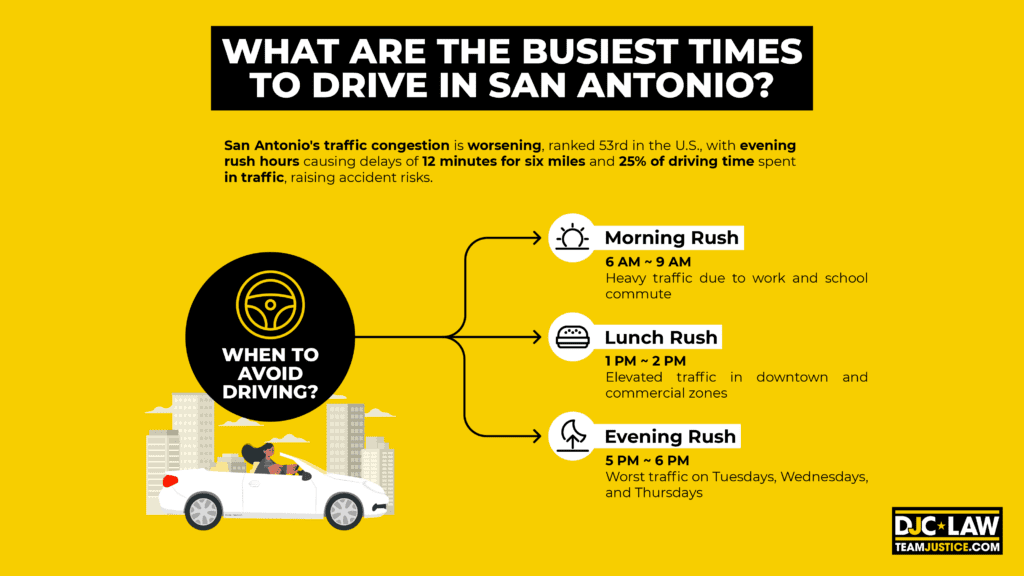
San Antonio traffic seems to be getting worse, contributing to a higher rate of accidents. Avoiding the busiest morning and evening rush-hour times can reduce the risk and avoid frustrating heavy traffic flow.
According to TomTom’s 2022 traffic index report, San Antonio is America’s 53rd most congested city. They found that the evening rush hour between 5 p.m. and 6 p.m. is the worst time to drive, with an average of 12 minutes to drive six miles. It’s also estimated that a quarter of driving time in the San Antonio Metropolitan Area is spent sitting in traffic.
If you’re looking to avoid the worst of the traffic, here’s when to avoid driving:
-
Morning Rush – Anywhere between 6 am and 9 am brings drivers out in force as people head to work and school.
-
Lunch Rush – The lunch hour between 1 pm and 2 pm results in elevated traffic levels in the downtown and commercial zones of the city.
-
Evening Rush – Between 5 pm and 6 pm are the worst times to drive, per TomTom, with traffic being the worst on Tuesdays, Wednesdays, and Thursdays. Friday evenings can also pose problems as people rush home from work or look to head out of the city for the weekend.
Speaking of weekends, it’s worth mentioning that traffic can become problematic around shopping and restaurant zones. Expect heavy traffic around major attractions, such as the airport and SeaWorld. It’s also worth mentioning that special events like Thanksgiving, Christmas, the Fiesta, and the rodeo season can exacerbate the problem.
If you must drive during the busiest times, exercise increased caution and drive defensively.
Why are Traffic Accidents More Common on San Antonio Highways?
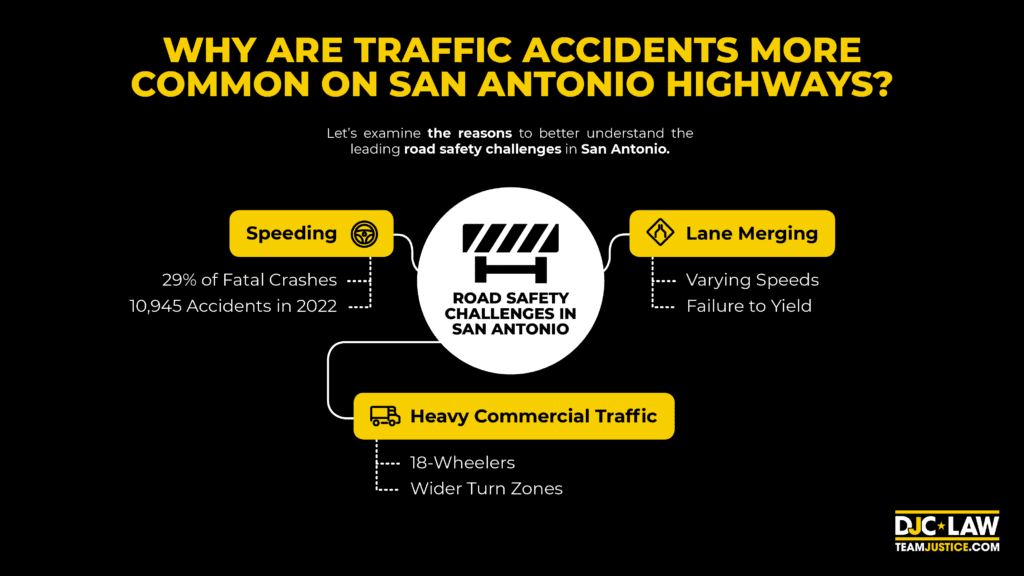
San Antonio highways are regular witnesses to catastrophic traffic accidents leading to life-changing injuries and fatalities. The most common reasons accidents occur are speeding, lane merging difficulties, and the presence of heavy commercial traffic.
Let’s examine these reasons further to better understand the leading road safety challenges in San Antonio.
Speeding
Speeding remains an enormous problem in San Antonio. According to the National Safety Council, 29% of all roadside fatalities have speeding as a contributing factor. In the Alamo City, the San Antonio Report found there were 10,945 crashes in 2022 because of drivers not obeying the speed limit.
Why is speeding so dangerous?
In short, it reduces how long a driver has to react to hazards. Furthermore, if a crash occurs, the additional force is likely to increase injury severity. After all, a car going 130 mph is far more dangerous than one going 30 mph.
Lane Merging
San Antonio’s highways connect with the downtown areas, meaning drivers must navigate drivers moving at different speeds. This can create problems when attempting to merge lanes. Plus, drivers often point out that drivers at the busiest intersections often fail to yield and allow other drivers to merge lanes.
Heavy Commercial Traffic
Another consequence of San Antonio’s position as a destination for several major highways is the presence of heavy commercial traffic. 18-wheelers are a regular presence on San Antonio’s roads, resulting in more fatalities because of their size.
It’s also no secret that many drivers often fail to account for the broader turning zones of larger commercial vehicles and other such nuances.
How Can Drivers Stay Safe on These Roads in San Antonio?
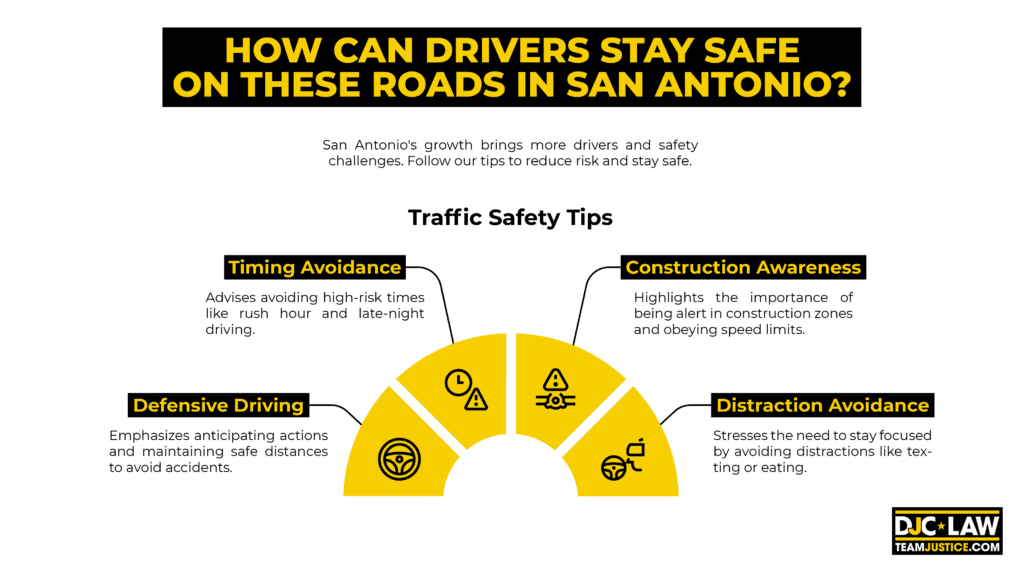
San Antonio is a growing city, and that means more drivers on the roads than before. Staying safe feels more complicated than ever before because it is, but drivers can take steps to reduce their risk and keep themselves and their families safe. However, if an accident does occur, consulting a San Antonio car accident lawyer can help you understand your rights and options for recovery.
In this section, we provide some tried-and-tested traffic safety tips that will help keep you accident-free.
Driving Defensively, Especially in High-Traffic Areas
Defensive driving means you don’t concentrate just on your own actions as a driver but on the actions of others around you. Knowing what others are doing enables you to anticipate their actions and consciously act to reduce the danger.
Examples of defensive driving include:
-
Maintaining a safe distance
-
Braking early
-
Knowing your route
-
Avoiding blind spots
-
Following your speed
Much of what makes a good defensive driver means simply being a good driver. If we all drove defensively, accident rates would collapse. See which defensive driving courses are available in your area now.
Avoiding Rush Hour and Late-Night Driving When Possible
More cars on the road means a higher chance of getting into an auto collision. Even the best drivers can fall victim to the negligence of others. If you can avoid driving during the busiest times of the day, such as the morning and evening rush hours, you’re less likely to be injured on the roads.
It’s also worth mentioning that late-night driving presents its own hazards. According to Teen Driver Source, the fatal crash rate among teen drivers is three times higher at night.
The hazards here are reduced visibility, lack of law enforcement, and a higher rate of people driving under the influence.
Staying Aware of Construction Zones and Obeying Posted Speed Limits
Pay attention to any construction zones or other temporary hazards that could be on your route. Take the time to map out your route and check the traffic news so that you know what you might encounter in advance.
One of the problems of this lack of awareness is that people also become unaware of temporary changes to the speed limits, resulting in them speeding. It’s a bigger problem than many think, with Work Zone Barriers reporting fatal injuries reaching a 17-year high in 2021.
Avoid Distractions Like Texting or Eating While Driving
Never multi-task while behind the wheel. The Texas Department of Transportation reveals that nearly one in six crashes in Texas were caused by a distracted driver, leading to 399 deaths and nearly 3,000 serious injuries.
Good drivers cover the three bases of distraction to stay fully focused, which are:
-
Eyes – Are your eyes ahead of you? Use your mirrors and peripheral vision to know what’s happening around you.
-
Hands – Both hands should be on the wheel at all times so that you have complete control of your vehicle.
-
Mind – Your mind is just as crucial for staying aware of what’s happening and giving yourself the chance to react in time. Avoid daydreaming while traversing the roads.
In short, the only thing you should be doing while driving is driving.
How Can a San Antonio Car Accident Lawyer Help?
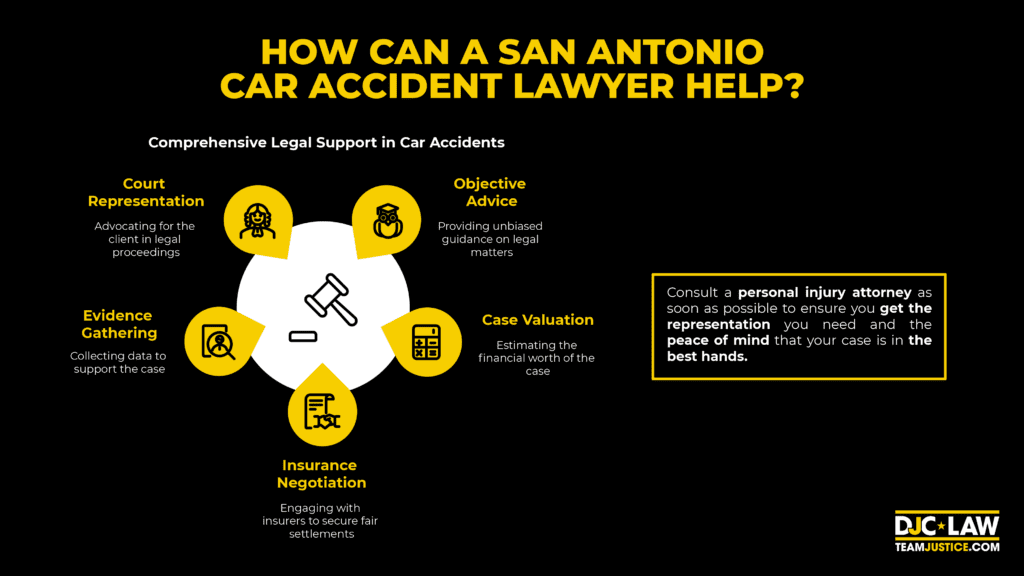
Traffic accidents happen, but what matters is that you get the compensation you deserve. You’ve got the legal right to a fair settlement that covers both your economic and non-economic damages. Working with a lawyer ensures you maximize your settlement and hold negligent drivers to account.
Some of the ways car accident attorneys help in the aftermath of an accident include:
-
Providing objective advice on your case.
-
Offering a case value.
-
Negotiating with your auto insurance company.
-
Gathering evidence to build your case.
-
Representing you in court, if necessary.
Consult a personal injury attorney as soon as possible to ensure you get the representation you need and the peace of mind that your case is in the best hands.
San Antonio Car Accident FAQs
What are the most common types of car accidents in San Antonio?
The most common types of car accidents are rear-end accidents followed by angle collisions. Some of the most common areas for these accidents are on some of San Antonio’s busiest intersections and highways.
How long do I have to file a San Antonio personal injury lawsuit?
Car accident lawsuits must be filed according to the Texas statute of limitations. If you’re injured in an accident that wasn’t your fault, you have two years from the date of your accident to file. If you miss the deadline, you’ll lose your right to claim entirely.
What damages can I claim from a San Antonio auto collision?
Car accident victims are entitled to claim for all tangible and intangible losses. Tangible losses could include lost wages, medical bills, and property damage. Your intangible losses can include pain and suffering, loss of enjoyment of life, and loss of companionship.


